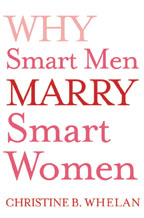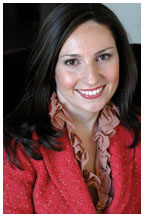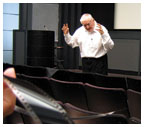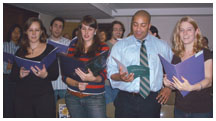November 22, 2006: Books and Arts
Smart women do wed
Christine Whelan ’99 dispels the myth that intelligent women intimidate
men
Dissecting moving images
Students learn from avant-garde filmmaker Peter Kubelka
For a complete list of books received, click here.
In her book, Christine Whelan ’99 argues that the more education a woman has, the more likely it is she will wed. (Courtesy Simon & Schuster) |
Smart
women do wed
Christine Whelan ’99 dispels the myth that intelligent
women intimidate men
By Katherine Hobson ’94
Christine Whelan ’99 used to buy into the notion that women who were smart and accomplished were less likely to get married. After all, Whelan, who has a doctorate in modern history from Oxford and has been a preceptor at Princeton, had been dumped by a boyfriend for being “intellectually intimidating.” And it was impossible to avoid media coverage of the studies saying that men would rather marry their secretaries than their workplace equals, or that the higher a woman’s IQ, the less likely she was to wed. With her background in economic and social history, Whelan figured she could at least get a book out of the fact that, as she told her mom on the phone one day, “I’m never going to get married.” She even had a catchy title: “Overqualified For Love.”
 But
a funny thing happened when she dug deeper into her subject: She discovered
those depressing data were outdated or misleading. Working from current
government statistics, a commissioned poll of more than 1,600 high achievers
of both genders, and interviews with a diverse group of women, she lays
out her case for a rosier view in a new book, Why Smart Men Marry
Smart Women, published by Simon & Schuster in October. Successful
men, she contends, also want to be with successful women, and having more
education actually increases the chances that a woman will wed.
But
a funny thing happened when she dug deeper into her subject: She discovered
those depressing data were outdated or misleading. Working from current
government statistics, a commissioned poll of more than 1,600 high achievers
of both genders, and interviews with a diverse group of women, she lays
out her case for a rosier view in a new book, Why Smart Men Marry
Smart Women, published by Simon & Schuster in October. Successful
men, she contends, also want to be with successful women, and having more
education actually increases the chances that a woman will wed.
The key is that women are marrying later — at about age 30, for those with graduate degrees or high salaries. Until they do, they’re what Whelan calls SWANS, or Strong Women Achievers, No Spouse. She interviews a number of SWANS in her book. Like Antoinette, a 36-year-old entrepreneur in Tucson, they’ve accomplished a lot and see marriage as a choice. “I don’t need a man to fix me,” Antoinette says in the book. “But I need a man emotionally.”
Women’s misperceptions of what men want are driven both by mistaken reports that their prospects in love dwindle as they accomplish more and by their own unpleasant dating experiences. But guess what, says Whelan: Dating is often unpleasant — for everyone.
Whelan’s book includes advice for women in the position she was in: Stop perpetuating the myth, be honest with men about your achievements, and ditch your Cinderella fantasies about someone swooping in to take care of you. And, she adds, be honest with yourself about what you want. Marrying later usually means having children later, and the biological clock is a reality. “If your priority is getting married and having children, you need to start thinking about it in your mid-20s,” she says.
Whelan, who also writes a relationship advice column on bustedhalo.com
and was editor-in-chief of The Daily Princetonian, says she would
like to follow up with a book on what happens in marriages between ambitious
high achievers — how they find balance when both partners have strong
career prospects. That, like her current research, may be sparked by her
own situation. Just when she started working on the book, she met Peter
Moyers ’00, a lawyer and former editor of The Nassau Weekly.
They’re getting married next June. ![]()
Katherine Hobson ’94 covers health and medicine at U.S. News & World Report.
For a complete list of books received, click here.
 Power, Speed, and Form: Engineers and the Making of the Twentieth Century
— David P. Billington ’50 and David P. Billington
Jr. (Princeton University Press). The authors explore the engineering
and the engineers behind innovations that transformed American life from
1876 to 1939: the telephone, electric power, oil refining, the automobile,
the airplane, radio, the steel bridge, and reinforced concrete. David
P. Billington ’50 is a professor of engineering at Princeton. David
P. Billington Jr. is an independent scholar.
Power, Speed, and Form: Engineers and the Making of the Twentieth Century
— David P. Billington ’50 and David P. Billington
Jr. (Princeton University Press). The authors explore the engineering
and the engineers behind innovations that transformed American life from
1876 to 1939: the telephone, electric power, oil refining, the automobile,
the airplane, radio, the steel bridge, and reinforced concrete. David
P. Billington ’50 is a professor of engineering at Princeton. David
P. Billington Jr. is an independent scholar.
 The Taker — J.M. Steele, a pseudonym for co-authors
Jadrien Steele ’96 and Richard Abate (Hyperion). The main character
in this humorous novel for teenagers is high-school senior Carly Biels.
She wants to attend Princeton, but her SAT scores are too low. After receiving
a mysterious text message from “The Taker,” who offers to
retake the test for her and guarantees a higher score, Biels wrestles
with accepting the offer or upping her score the old-fashioned way, by
studying. Steele is a screenwriter. Abate is a literary agent.
The Taker — J.M. Steele, a pseudonym for co-authors
Jadrien Steele ’96 and Richard Abate (Hyperion). The main character
in this humorous novel for teenagers is high-school senior Carly Biels.
She wants to attend Princeton, but her SAT scores are too low. After receiving
a mysterious text message from “The Taker,” who offers to
retake the test for her and guarantees a higher score, Biels wrestles
with accepting the offer or upping her score the old-fashioned way, by
studying. Steele is a screenwriter. Abate is a literary agent.
 The Aeneid — translated by Robert Fagles, with an introduction
by Bernard Knox (Viking). In this new translation of the epic poem, Fagles
has brought a contemporary voice to the narrator of the poem, ancient
Rome’s poet Publius Vergilius Maro, better known as Virgil. Maro
tells the story of the origins of Rome through the tale of the warrior
Aeneas, who becomes entangled in a tragic love affair, descends to the
world of the dead, and finally reaches Italy. Fagles is a professor of
comparative literature, emeritus, at Princeton.
The Aeneid — translated by Robert Fagles, with an introduction
by Bernard Knox (Viking). In this new translation of the epic poem, Fagles
has brought a contemporary voice to the narrator of the poem, ancient
Rome’s poet Publius Vergilius Maro, better known as Virgil. Maro
tells the story of the origins of Rome through the tale of the warrior
Aeneas, who becomes entangled in a tragic love affair, descends to the
world of the dead, and finally reaches Italy. Fagles is a professor of
comparative literature, emeritus, at Princeton. ![]()
By K.F.G.
For a complete list of books received, click here.
This fall Peter Kubelka shares his view of film and the world in his seminar. (Photo courtesy The Program in Visual Arts) |
Dissecting
moving images
Students learn from avant-garde filmmaker Peter Kubelka
By Maria LoBiondo
Avant-garde filmmaker Peter Kubelka’s entire body of work — seven films over a 50-plus-year career — can be viewed in little more than an hour. But the Austrian native believes that these films absorb the viewer in the rhythm, imagery, and sound by pushing filmmaking to its most concentrated form.
The seminar he is teaching at Princeton this fall, “Special Topics in Film History: Film, Food, and Other Art,” is no less intense. Kubelka, a fellow in the visual arts program, endeavors to impart not only his ideas about filmmaking, but also how he, as an artist and theoretician, looks at the world.
Each three-hour seminar includes film — mainly Kubelka’s — and comparisons to other media to articulate his message. The media spectrum includes architecture, painting, sculpture, literature, dance, music, and cooking — which he calls the oldest art form, on a par with poetry as a means of communication.
“Students will not leave the course with a recipe [for how to view the world] but with an introduction to a way of thinking and seeing the world,” Kubelka says.
Kubelka’s early films are often cited as forerunners of the American structural film movement — a term coined by Princeton professor P. Adams Sitney that describes film artists who had moved away from a complex and condensed form of cinema to a more simplified art. Kubelka’s works are cited and viewed in numerous university film courses; he has lectured in this country and taught in Frankfurt, Germany. Between films he also co-founded and was the curator at the Austrian Film Museum and co-founded, with Sitney and others, the Anthology Film Archives in New York City.
During the third meeting of his Princeton class, Kubelka showed his film Adebar, named for the nightclub where it was shot in Vienna. Silhouettes of jitterbugging dancers alternate from free-form to freeze-frame, from recognizable figures to abstract close-ups, in rhythm to African flute music. “I wanted ... the film [to] also dance and not be a reproduction of dance,” he says.
Using an editing table to analyze a section of the film, Kubelka focuses on a sequence of a couple dancing, moving apart, and then the man seen solo — suggesting the concept of romance Kubelka had as a 22-year-old when he created Adebar. “This is a story told in Hollywood 20 to 30 times a year. I condensed it into one-and-a-half minutes,” he says dryly.
“This class has made me reach, creatively,” said Near Eastern
studies major Flannery Becker ’09, one of about 40 students in the
class. “I’ve never analyzed a movie or even stopped to think
about what I was watching.” But now, she says, she has learned to
look for what the creator of the art film “wants us to see”
by looking for “patterns in the music and how they connect to images
on the screen.” ![]()
Maria LoBiondo is a PAW contributor.
(Photo courtesy Young New Yorkers’ chorus)
Members of the Young New Yorkers’ Chorus rehearse for their upcoming holiday concert at Holy Trinity Church in New York City on Dec. 2. Pictured in the front row, from the left, are: Allison Doerr *05, Susan Schaefer ’01, Alan Poussaint ’01, and Laura Vanderkam ’01. Not pictured are Stella Daily ’00 and Raoul Bhavnani ’93. Founded five years ago to give vocalists in their 20s and 30s an opportunity to perform classical music, the Young New Yorkers’ Chorus puts on about four concerts a year. For times and locations, go to www.ynyc.org.



